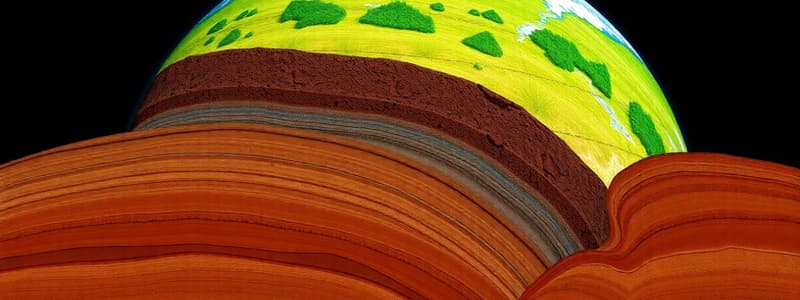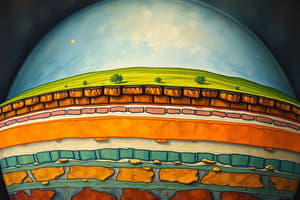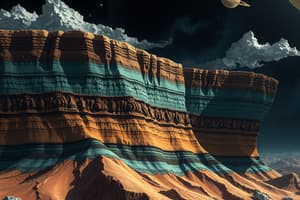Podcast
Questions and Answers
Which type of seismic wave is known to travel through both solid and liquid layers of the Earth?
Which type of seismic wave is known to travel through both solid and liquid layers of the Earth?
- Rayleigh waves
- P-waves (correct)
- S-waves
- Surface waves
Convergent plate boundaries are associated with the creation of new crust.
Convergent plate boundaries are associated with the creation of new crust.
False (B)
What is the main cause of earthquakes?
What is the main cause of earthquakes?
The sudden release of energy along faults.
The movement and interaction of the Earth's lithospheric plates is explained by the theory of __________.
The movement and interaction of the Earth's lithospheric plates is explained by the theory of __________.
Match the following plate boundary types with their characteristics:
Match the following plate boundary types with their characteristics:
Which layer of the Earth is the thickest?
Which layer of the Earth is the thickest?
The outer core of the Earth is a solid layer composed of iron and nickel.
The outer core of the Earth is a solid layer composed of iron and nickel.
What is the primary compositional difference between oceanic and continental crust?
What is the primary compositional difference between oceanic and continental crust?
The movement of the liquid iron in the outer core creates the Earth's ______.
The movement of the liquid iron in the outer core creates the Earth's ______.
Which of the following processes is responsible for the movement of tectonic plates?
Which of the following processes is responsible for the movement of tectonic plates?
The Earth's interior temperature increases with depth.
The Earth's interior temperature increases with depth.
What distinguishes the asthenosphere from other layers in the mantle?
What distinguishes the asthenosphere from other layers in the mantle?
Match the following Earth layers with their characteristics:
Match the following Earth layers with their characteristics:
Flashcards
Earth's Crust
Earth's Crust
The outermost solid layer of Earth, relatively thin compared to other layers.
Earth's Mantle
Earth's Mantle
The thickest layer of Earth, composed primarily of silicate rocks. It's divided into the upper and lower mantle, responsible for plate tectonic movement.
Earth's Outer Core
Earth's Outer Core
A liquid layer of iron and nickel responsible for Earth's magnetic field.
Earth's Inner Core
Earth's Inner Core
Signup and view all the flashcards
Plate Tectonics
Plate Tectonics
Signup and view all the flashcards
Geothermal Gradient
Geothermal Gradient
Signup and view all the flashcards
Asthenosphere
Asthenosphere
Signup and view all the flashcards
Heat Transfer in Earth's Interior
Heat Transfer in Earth's Interior
Signup and view all the flashcards
What are seismic waves?
What are seismic waves?
Signup and view all the flashcards
How are different seismic wave types used to study the Earth's interior?
How are different seismic wave types used to study the Earth's interior?
Signup and view all the flashcards
What is Plate Tectonics?
What is Plate Tectonics?
Signup and view all the flashcards
Describe the major types of plate boundaries.
Describe the major types of plate boundaries.
Signup and view all the flashcards
What is Volcanism?
What is Volcanism?
Signup and view all the flashcards
Study Notes
Structure of the Earth
- Earth's interior is layered like an onion, each layer exhibiting unique physical and chemical properties.
- Layers include crust, mantle, outer core, and inner core.
- The crust, Earth's outer shell, is relatively thin compared to other layers.
- The mantle is the thickest layer, primarily composed of silicate rocks.
- The upper mantle contains the asthenosphere, a semi-molten layer enabling plate movement.
- The outer core is liquid iron and nickel, producing Earth's magnetic field via electric currents.
- The inner core is solid iron and nickel, resisting melting due to immense pressure.
Earth's Crust
- Earth's crust is divided into large and small plates moving relative to each other.
- Plate movement is driven by mantle convection currents.
- Plate tectonics causes earthquakes, volcanoes, and mountain building.
- Oceanic crust is denser and thinner than continental crust.
- Continental crust is less dense and thicker.
- The crust is made of igneous, sedimentary, and metamorphic rocks.
Mantle
- The mantle is a highly viscous solid layer beneath the crust; exhibiting plasticity and slow flow over geologic time.
- Convection currents within the mantle are crucial for plate tectonic motion.
- Mantle composition varies regionally, primarily silicate minerals.
Core
- The core, the innermost layer, is composed of iron and nickel.
- The outer core is liquid, facilitating the geodynamo process for Earth's magnetic field.
- The inner core is solid despite high temperatures, due to immense pressure.
- The core strongly influences Earth's overall heat and magnetic shield.
Thermal Structure
- Earth's interior is extremely hot.
- Temperature increases with depth, known as the geothermal gradient.
- Heat from the interior moves to the surface through conduction, convection, and radiation.
Seismic Waves
- Seismic waves, originating from earthquakes, reveal insights into Earth's internal structure.
- Scientists study P-waves and S-waves to map layers and their properties using reflection and refraction.
Plate Tectonics
- The theory of plate tectonics describes the movement and interaction of lithospheric plates.
- Plate boundaries include divergent (new crust), convergent (mountain ranges/subduction), and transform (earthquakes).
Geological Processes
- Volcanism involves magma surfacing as lava, ash, and gases—influenced by subsurface conditions.
- Earthquakes arise from energy release along faults due to plate movement.
- Earthquake magnitude and frequency depend on the plate boundary type and fault characteristics.
- Mountain building happens from tectonic forces uplifting and compressing the crust.
Studying That Suits You
Use AI to generate personalized quizzes and flashcards to suit your learning preferences.




